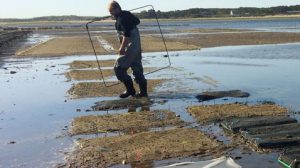Search results for: Canadian Online Pharmacy %E2%AD%90 www.HealthMeds.online %E2%AD%90 Cialis Mg Canada - Is Cialis Generic Available In Canada
Federal Crop Insurance for Massachusetts Quahog Farmers
Federal Crop Insurance for Massachusetts Quahog Farmers Helpful to educators and students Leavitt, D.F. Focal Points, 2 pp., 1999 WHOI-G-99-001 Also available online: click here
Read MoreStudy Provides Measurement of Nitrogen Removal by Local Shellfish
Towns along Cape Cod and the Islands are looking to shellfish not only as tasty culinary treats, but also for help cleaning up waters degraded by excess nitrogen in the region. While nitrogen is essential for all plants and animals, too much nitrogen in ponds and waterways—often caused by fertilizer runoff and septic tanks—can fuel…
Read MoreFunding Opportunities
Research Funding Opportunities WHOI Sea Grant Program Funding Opportunities General Program Development Funds – OPEN Small projects focused on: Research or proof-of-concept; Diversity, equity, inclusion and justice (DEIJ); Extension, education, communications; Travel; Graduate student support; Workshops or conferences. Woods Hole Sea Grant Biennial Request for Proposals – Closed Depending on availability of funds, WHOI…
Read MoreThe Ocean Enterprise Concept: A National Strategy for Resource Development
The Ocean Enterprise Concept: A National Strategy for Resource Development Ross, D.A., C.E. McLain, and J.E. Dailey Sea Technology, pp. 15-20, 1989 WHOI-R-89-019 In the late 1980’s less than 1% of the annual resources consumed in the United States comes from the sea. Yet the March 1983 Exclusive Economic Zone (EEZ) Proclamation by President Ronald…
Read MoreEvaluation of Coastal Erosion Hazards: Results from a National Study and a Massachusetts Perspective
Evaluation of Coastal Erosion Hazards: Results from a National Study and a Massachusetts Perspective Helpful to educators and students. WHOI Sea Grant Focal Points, 3 pp., 2001 WHOI-G-01-003
Read MoreCyclical Behavior of the Tidal Inlet at Nauset Beach, Chatham, Massachusetts
Cyclical Behavior of the Tidal Inlet at Nauset Beach, Chatham, Massachusetts Giese, G.S. In: Aubrey, D.G. and L. Weishar (eds.), Hydrodynamics and Sediment Dynamics of Tidal Inlets. Lecture Notes on Coastal and Estuarine Studies, Springer-Verlag New York, Inc., Vol. 29, pp. 269-283, 1988 WHOI-R-88-025 Study of historical data concerning shoreline forms and change on southeastern…
Read MoreFocal Points – Evaluation of Coastal Erosion Hazards: Results from a National Study and a Massachusetts Perspective
Focal Points – Evaluation of Coastal Erosion Hazards: Results from a National Study and a Massachusetts Perspective August 20010 – While it may not be surprising to learn that coastal property owners — particularly those with property located within a few hundred feet from shore — face risks from flooding, a recent study found that,…
Read MorePerigean Spring Tides — Predicting Potential Disasters: How Tidal Information May Save You From a Coastal Crisis
Perigean Spring Tides — Predicting Potential Disasters: How Tidal Information May Save You From a Coastal Crisis Helpful to educators and students. Giese, G.S. Marine Extension Bulletin, 2 pp., 1998 WHOI-G-98-007
Read MoreA Changing Ocean Policy Horizon for Marine Science
A Changing Ocean Policy Horizon for Marine Science Ross, D.A. Ocean Development and International Law, Vol. 15, Nos. 3/4, pp. 221-232, 1985 WHOI-R-85-010
Read MoreBulletin: Beach and Dune Profiles: An Educational Tool for Observing and Comparing Dynamic Coastal Environments
Bulletin: Beach and Dune Profiles: An Educational Tool for Observing and Comparing Dynamic Coastal Environments Beaches and dunes are in constant motion, continually changing shape and shifting position in response to winds, waves, tides, relative sea level, and human activities. The most significant changes occur seasonally and following storms.
Read More
